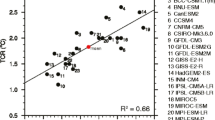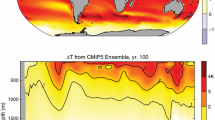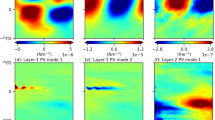Abstract
A method is introduced which allows the calculation of long-term climate trends within the framework of a coupled atmosphere-ocean circulation model. The change in the seasonal cycle of incident solar radiation induced by varying orbital parameters has been accelerated by factors of 10 and 100 in order to allow transient simulations over the period from the mid-Holocene until today, covering the last 7,000 years. In contrast to conventional time-slice experiments, this approach is not restricted to equilibrium simulations and is capable to utilise all available data for validation. We find that opposing Holocene climate trends in tropics and extra-tropics are a robust feature in our experiments. Results from the transient simulations of the mid-Holocene climate at 6,000 years before present show considerable differences to atmosphere-alone model simulations, in particular at high latitudes, attributed to atmosphere-ocean-sea ice effects. The simulations were extended for the time period 1800–2000 AD, where, in contrast to the Holocene climate, increased concentrations of greenhouse gases in the atmosphere provide for the strongest driving mechanism. The experiments reveal that a Northern Hemisphere cooling trend over the Holocene is completely cancelled by the warming trend during the last century, which brings the recent global warming into a long-term context.













Similar content being viewed by others
References
Berger AL (1978) Long-term variations of daily insolation and Quaternary climatic changes. J Atmos Sci 35:2362–2367
Bertrand C, Loutre MF, Berger A (2002a) High frequency variations of the Earth’s orbital parameters and climate change. Geophys Res Lett 29: DOI: 10.1029/2002GL015,622
Bertrand C, Loutre MF, Crucifix M, Berger A (2002b) Climate of the last millennium: a sensitivity study. Tellus 54A:221–224
Boden TA., Kaiser DP, Sepanski RJ, Stoss FW (1994) Trends ’93: a compendium of data on global change, Carbon Dioxide Information Analysis Center ORNL/CDIAC-65. Oak Ridge National Laboratory, Oak Ridge
Boville AB, Gent PR (1998) The NCAR climate system model, version one. J Clim 11:1115–1130
Bryan K (1984) Accelerating the convergence to equilibrium of ocean-climate models. J Phys Oceanogr 14:666–673
Clark PU, Pisias NG, Stocker TF, Weaver AG (2002) The role of thermohaline circulation in abrupt climate change. Nature 415:863–869
Claussen M (1997) Modeling bio-geophysical feedback in the African and Indian monsoon region. Climate Dyn 13:247–257
Claussen M, Gayler V (1997) The greening of Sahara during the mid-Holocene: results of an interactive atmosphere-biome model. Global Ecol Biogeogr Lett 6:369–377
Claussen M, Kubatzki C, Brovkin V, Ganopolski V, Hoelzmann P, Pachur HJ (1999) Simulation of an abrupt change in Saharan vegetation in the mid-Holocene. Geophys Res Lett 24:2037–2040
Claussen M et al (2002) Earth system models of intermediate complexity: closing the gap in the spectrum of climate system models. Climate Dyn 18:579–586
Clement AC, Seager R, Cane MA (1999) Orbital controls on the el nino/southern oscillation and the tropical climate. Paleoceanography 14:441–456
CLIMAP Project Members (1976) The surface of the ice age Earth. Science 191:1131–1137
Crowley TJ (2000) Causes of climate change over the past 1000 years. Science 289:270–277
Crucifix M, Loutre M-F, Tulkens P, Fichefet T, Berger A (2002) Climate evolution during the Holocene: a study with an Earth system model of intermediate complexity. Climate Dyn 19:43–60
Emeis K-C, Struck U, Schulz H-M, Rosenberg R, Bernasconi S, Erlenkeuser H, Sakamoto T, Martinez-Ruiz F (2000) Temperature and salinity variations of Mediterranean Sea surface waters over the last 16,000 years from records of planktonic stable oxygen isotopes and alkenone unsaturation ratios. Palaeogeogr Palaeoclimatol Palaeoecol 158:259–280
Etheridge DM, Steele L, Langenfelds R, Francey R, Barnola J, Morgan V (1996) Natural and anthropogenic changes in atmospheric CO2 over the last 1000 years from air in Antarctic ice and firn. J Geophys Res 101:4115–4128
Etheridge DM, Steele L, Francey R, Langenfelds R (1998) Atmospheric methane between 1000 a.d. and present: evidence of anthropogenic emissions and climatic variability. J Geophys Res 103:15979–15993
Felis T, Lohmann G, Kuhnert H, Lorenz SJ, Scholz D, Pätzold J, Al-Rousan SA, Al-Moghrabi SM (2004) Increased seasonality in Middle East temperatures during the last interglacial period. Nature 429:164–168
Fichefet T, Hovine S, Duplessy J-C (1994) A model study of the Atlantic thermohaline circulation during the last glacial maximum. Nature 372:252–255
Ganopolski A, Rahmstorf S (2001) Rapid changes of glacial climate simulated in a coupled climate model. Nature 409:153–158
Ganopolski A, Kubatzki C, Claussen M, Brovkin V, Petoukhov V (1998a) The influence of vegetation-atmosphere-ocean interaction on climate during the mid-Holocene. Science 280:1916–1919
Ganopolski A, Rahmstorf S, Petoukhov V, Claussen M (1998b) Simulation of modern and glacial climates with a coupled global model of intermediate complexity. Nature 391:351–356
Gates WL (1976) The numerical simulation of ice-age climate with a global general circulation model. J Atmos Sci 33:1844–1873
Grootes PM, Stuiver M, White JWC, Johnsen SJ, Jouzel J (1993) Comparison of oxygen isotope records from the GISP2 and GRIP Greenland ice cores. Nature 366:552–554
Grötzner A, Sausen R, Claussen M (1996) The impact of sub-grid scale sea-ice inhomogeneities on the performance of the atmospheric general circulation model ECHAM3. Climate Dyn 12:477–496
Hewitt CD, Mitchell JFB (1998) A fully coupled GCM simulation of the climate of the mid-Holocene. Geophys Res Lett 25:361–364
Hewitt CD, Broccoli AJ, Mitchell JFB, Stouffer RJ (2001) A coupled model study of the last glacial maximum: was part of the North Atlantic relatively warm? Geophys Res Lett 28:1571–1574
Hoyt DV, Schatten KH (1993) A discussion of plausible solar irradiance variations. J Geophys Res 98:18895–18906
Hurrell JW (1995) Decadal trends in the North Atlantic oscillation: regional temperatures and precipitation. Science 269:676–679
Imbrie J et al (1992) On the structure and origin of major glaciation cycles: 1. Linear responses to Milankovitch forcing. Paleoceanography 7:701–738
Imbrie J et al (1993) On the structure and origin of major glaciation cycles: 2. The 100,000-year cycle. Paleoceanography 8:699–735
Indermühle A et al (1999) Holocene carbon-cycle dynamics based on CO2 trapped in ice at Taylor Dome, Antarctica. Nature 398:121–126
IPCC (2001) Climate change 2001: the scientific basis, contribution of working group I to the Third Assessment Report of the IPCC, Houghton JT et al (eds), Cambridge University Press, Cambridge, UK
Joussaume S, Braconnot P (1997) Sensitivity of paleoclimate simulation results to season definitions. J Geophys Res 102:1943–1956
Joussaume S, Taylor KE (2000) The paleoclimate modeling intercomparison project. In: Braconnot P (ed) Paleoclimate modeling intercomparison project (PMIP): proceedings of the third PMIP workshop, Canada, 4–8 October 1999, WCRP-111, WMO/TD-1007. World Meteorological Organization, pp 9–24
Keigwin LD, Pickart RS (1999) Slope water current over the laurentian fan on interannual to millennial time scales. Science 286:520–523
Kim S-J, Flato GM, Boer GJ, McFarlane N (2002) A coupled climate model simulation of the last glacial maximum, Part 1: transient multi-decadal response. Climate Dyn 19:515–537
Kitoh A, Murakami S (2002) Tropical pacific climate at the mid-Holocene and the last glacial maximum simulated by a coupled atmosphere-ocean general circulation model. Paleoceanography 17: DOI: 10.1029/2001PA000,724
Lean J, Rind D (1998) Climate forcing by changing solar radiation. J Clim 11:3069–3094
Legutke S, Voss R (1999) The Hamburg atmosphere-ocean coupled circulation model ECHO-G, Technical Report 18. Deutsches Klimarechenzentrum, Hamburg
Liu Z, Brady E, Lynch-Stieglitz J (2003) Global ocean response to orbital forcing in the Holocene. Paleoceanography 18. DOI: 10.1029/2002PA000,819
Lohmann G, Lorenz SJ, Prange M (2004) Northern high-latitude climate changes during the Holocene as simulated by circulation models. Agu Monograph Series, American Geophysical Union (accepted)
Lorenz S, Grieger B, Helbig P, Herterich K (1996) Investigating the sensitivity of the atmospheric general circulation model ECHAM 3 to paleoclimatic boundary conditions. Int J Earth Sci 85:513–524
Maier-Reimer E, Mikolajewicz U, Hasselmann K (1993) Mean circulation of the Hamburg LSG OGCM and its sensitivity to the thermohaline surface forcing. J Phys Oceanogr 23:731–757
Manabe S, Broccoli AJ (1985) A comparison of climate model sensitivity with data from the last glacial maximum. J Atmos Sci 42:2643–2651
Mann ME, Jones PD (2003) Global surface temperatures over the past two millennia. Geophys Res Lett 30. DOI 10.1029/2003GL017,814
Mann ME, Bradley RS, Hughes MK (1998) Global-scale temperature patterns and climate forcing over the past six centuries. Nature 392:779–787
Mann ME, Bradley RS, Hughes MK (1999) Northern hemisphere temperature during the past millennium: inferences, uncertainties, and limitations. Geophys Res Lett 26:759–762
Marchal O et al (2002) Apparent long-term cooling of the sea surface in the northeast Atlantic and mediterranean during the Holocene. Quat Sci Rev 21:455–483
Marsland SJ, Latif M, Legutke S (2003) Variability of the Antarctic circumpolar wave in a coupled ocean-atmosphere model. Ocean Dyn 53:323–331
Milankovitch M (1941) Kanon der Erdbestrahlung und seine Anwendung auf das Eiszeitenproblem, vol 132. Royal Serbian Academy, Belgrad
Pacanowski RC, Dixon KD, Rosati A (1993) The G.F.D.L. modular ocean model users guide, GFDL Ocean Group, technical report 2. NOAA/Geophysical Fluid Dynamics Laboratory, Princeton
Prange M, Lohmann G, Paul A (2003) Influence of vertical mixing on the thermohaline hysteresis: analyses of an OGCM. J Phys Oceanogr 33:1707–1721
Raible C, Luksch U, Fraedrich K, Voss R (2001) North Atlantic decadal regimes in a coupled GCM simulation. Climate Dyn 18:321–330
Rimbu N, Lohmann G, Kim J-H, Arz HW, Schneider RR (2003) Arctic/North Atlantic Oscillation signature in Holocene sea surface temperature trends as obtained from alkenone data. Geophys Res Lett 30:1280–1283
Rimbu N, Lohmann G, Lorenz SJ, Kim J-H, Schneider RR (2004) Holocene climate variability as derived from alkenone sea surface temperature and coupled ocean-atmosphere model experiments. Climate Dyn 23:215–227
Rodgers K, Friedrichs P, Latif M (2004) Decadal enso amplitude modulations and their effect on the mean state. J Clim (in press)
Roeckner E et al (1992) Simulation of the present-day climate with the ECHAM model: impact of model physics and resolution, Report 93. Max-Planck-Institut für Meteorologie
Roeckner E et al (1996) The atmospheric general circulation model ECHAM-4: model description and simulation of the present-day climate, Report 218. Max-Planck-Institut für Meteorologie
Rohling E, PMayewski P, Abu-Zied R, Casford J, Hayes A (2002) Holocene atmosphere-ocean interactions: records from Greenland and the Aegean Sea. Climate Dyn 18:587–593
Shin S-I, Liu Z, Otto-Bliesner B, Brady EC, Kutzbach JE, Harrison SP (2003) A simulation of the last glacial maximum climate using the NCAR-CCSM. Climate Dyn 20:127–151
Shindell DT, Rind D, Balachandran N, Lean J, Lonergan P (1999) Solar cycle variability, ozone, climate. Science 284:305–308
Shindell DT, Schmidt GA, Mann ME, Rind D, Waple A (2001) Solar forcing of regional climate change during the Maunder Minimum. Science 294:2149–2152
Shindell DT, Schmidt GA, Miller RL, Mann ME (2003) Volcanic and solar forcing of climate change during the preindustrial era. J Clim 16:4094–4107
Sowers T, Alley RB, Jubenville J (2003) Ice core records of atmospheric N2O covering the last 106,000 years. Science 301:945–948
Stocker TF, Wright D, Mysak L (1992) A zonally averaged, coupled ocean-atmosphere model for paleoclimate studies. J Clim 5:773–797
Tarasov P et al (1998) Present-day and mid-Holocene biomes reconstructed from pollen and plant macrofossil data from the former soviet union and mongolia. J Biogeography 25:1029–1053
Terray L, Valcke S, Piacentini A (1998) The OASIS coupler user guide, version 2.2, Technical Report TR/CMGC/98-05, CERFACS
Texier D, de Noblet N, Harrison SP, Haxeltine A, Jolly D, Joussaume S, Laarif F, Prentice IC, Tarasov P (1997) Quantifying the role of biosphere-atmosphere feedbacks in climate change: coupled model simulations for 6000 years BP and comparison with palaeodata for northern Eurasia and northern Africa. Climate Dyn 13:865–882
Thompson DWJ, Wallace JM (1998) The Arctic oscillation signature in the wintertime geopotential height and temperature fields. Geophys Res Lett 25:1297–1300
Voss R, Mikolajewicz U (2001) The climate of 6000 years BP in near-equilibrium simulations with a coupled AOGCM. Geophys Res Lett 28:2213–2216
Voss R, Sausen R (1996) Techniques for asynchronous and periodically synchronous coupling of atmosphere and ocean models, Part II: Impact of variability. Climate Dyn 12:605–614
Voss R, Sausen R, Cubasch U (1998) Periodically synchronously coupled integrations with the atmosphere-ocean general circulation model ECHAM3/LSG. Climate Dyn 14:249–266
Weaver AL, Eby M, Fanning AF, Wiebe EC (1998) Simulated influence of carbon dioxide, orbital forcing and ice sheets on the climate of the last glacial maximum. Nature 394:847–853
Wolff J-O, Maier-Reimer E, Legutke S (1997) The Hamburg ocean primitive equation model HOPE, technical report 13. Deutsches Klimarechenzentrum, Hamburg
Zorita E, González-Rouco F, Legutke S (2003) Testing the Mann et al. (1998) approach to paleoclimate reconstructions in the context of a 1000-Yr control simulation with the ECHO-G coupled climate model. J Clim 16:1378–1390
Acknowledgements
We like to thank C. Heinze and J. Jungclaus and two anonymous reviewers for their helpful comments which improved the manuscript considerably. M. Claussen is acknowledged for providing us with part of the ECHAM3 data and S. Schubert for help with preparing Fig. 13. The model simulations have been done at the Deutsches Klimarechenzentrum (DKRZ), Hamburg, Germany. We thank S. Legutke for her support concerning the ECHO-G model experiments as well as the staff of the Max-Planck-Institut für Meteorologie and the DKRZ for technical support. This study was funded by grants from the German Ministry of Research and Education (BMBF) through the program DEKLIM.
Author information
Authors and Affiliations
Corresponding author
Rights and permissions
About this article
Cite this article
Lorenz, S.J., Lohmann, G. Acceleration technique for Milankovitch type forcing in a coupled atmosphere-ocean circulation model: method and application for the Holocene. Climate Dynamics 23, 727–743 (2004). https://doi.org/10.1007/s00382-004-0469-y
Received:
Accepted:
Published:
Issue Date:
DOI: https://doi.org/10.1007/s00382-004-0469-y




